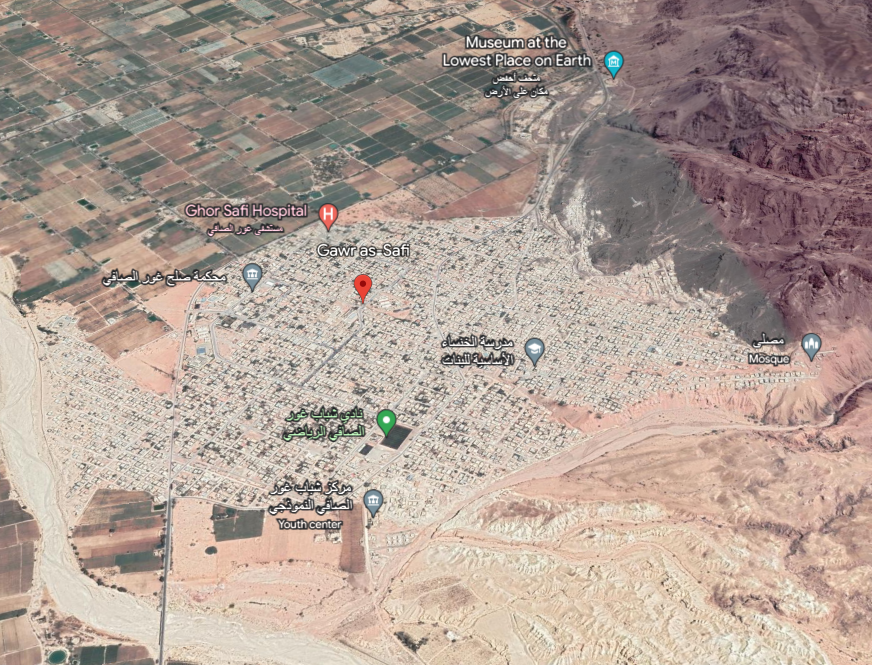Safi
| Transliterated Name | Source | Name |
|---|---|---|
| Safi | Arabic | |
| Ghor es-Safi | Arabic | |
| Ghawr as-Safi | Arabic | |
| Zoara | Greek Geographers such as Ptolemy in the 2nd c. BCE | ZOAPA |
| Zooron | Greek Geographers such as Ptolemy in the 2nd c. BCE | ZOOPΩN |
| Zoara | Byzantine name recorded on the Madaba Map | |
| Zoora | Onomasticon of Eusebius | |
| Balak | Septuagint | |
| Segor | Latin (Vulgate) | |
| Palmaria | Crusader name | |
| Sugar | Middle Ages Arabic | |
| Zughar | Middle Ages Arabic | |
| Zoar | Biblical Hebrew | |
| Bela | Biblical Hebrew | |
| Bela-Zoar | Biblical Hebrew | |
| Tzuor, Tsoar | Biblical Hebrew (Genesis 19:22) | |
| Za-e-or | Sumerian cuneiform in the Elba tablets ( Politis et al. (2020:30) citing Giovanni Pettinato) |
Ghor-es-Safi is located on the SE end of the Dead Sea. It was known as Zoora or
Zoara in Byzantine times - as evidenced from its designation on the
Madaba Map. In the Biblical story of Sodom and Gomarrah
, it is mentioned as one of the five cities of the plain
(Genesis 14:8).
Excavations have revealed a long history of occupation in the surrounding area going back
to Paleolithic and Neolithic periods with extensive and flourishing cultures during the Early Bronze, Nabatean-Roman,
Byzantine, and Mamluk periods.
(
R. Thomas Schaub in Meyers et al, 1997).
R. Thomas Schaub in Meyers et al (1997) relates the following about attempts to associate Safi with older Biblical place names
Attempts to identify archaeological sites with place names mentioned in literary sources have met with varying degrees of success. The biblical Cities of the Plain (Gn. 13:12 , 19:29), Sodom, Gomorrah, Admah, Seboiim, and Zoar (Gn. 14:2, 8) have been located in the south by most commentators, although some have argued for a location north of the Dead Sea. Others have tried to place the ruins of these cities below the southern basin of the Dead Sea (generally rejected today). Recently, several efforts have linked the cities with the EB ruins at Bab edh-Dhra' and Numeira. Others continue to stress the mythical, ahistorical quality of the ancient traditions.Safi is located close to the Sanctuary of Agios Lot (Deir 'Ain 'Abata). The Notitia Dignitatum (34.26) states that a garrison was stationed at Zoora during the late 4th century CE ( Meimaris and Kritikakou, 2005).
- Fig. 2 - Map of Sites
around Ghor es-Safi from Meimaris and Kritikakou (2005)
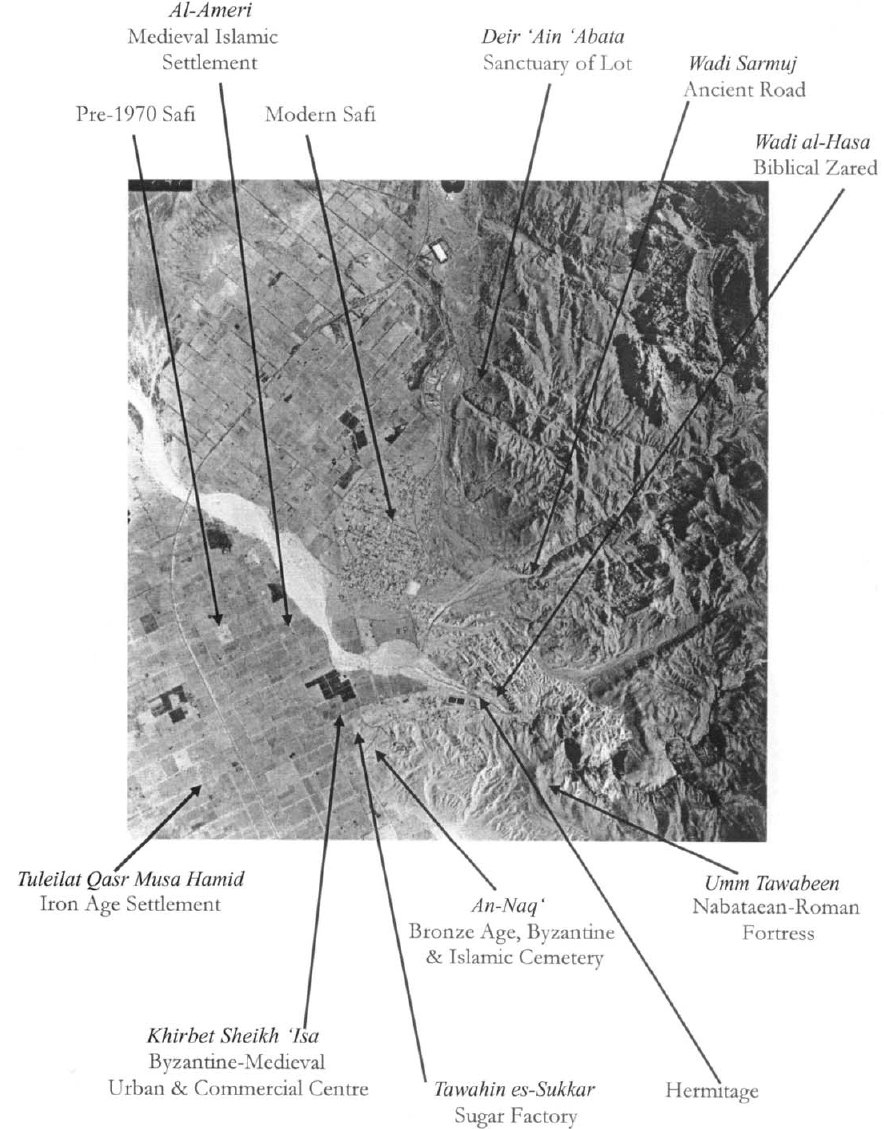
 Fig. 2.
Fig. 2.
Annotated 1992 aerial photograph of Zoora in the Ghor es-Safi
Meimaris and Kritikakou (2005) - Fig. 1a - Annotated
1953 aerial photograph of Ghor es-Safi from Politis et al. (2007)

 Fig. 1a
Fig. 1a
Annotated 1953 aerial photograph of Ghor es-Safi
(courtesy of Royal Jordanian Geographic Centre, Amman)
Politis et al. (2007) - Fig. 1b - Annotated
1953 aerial photograph of Ghor es-Safi surroundings from Politis et al. (2007)
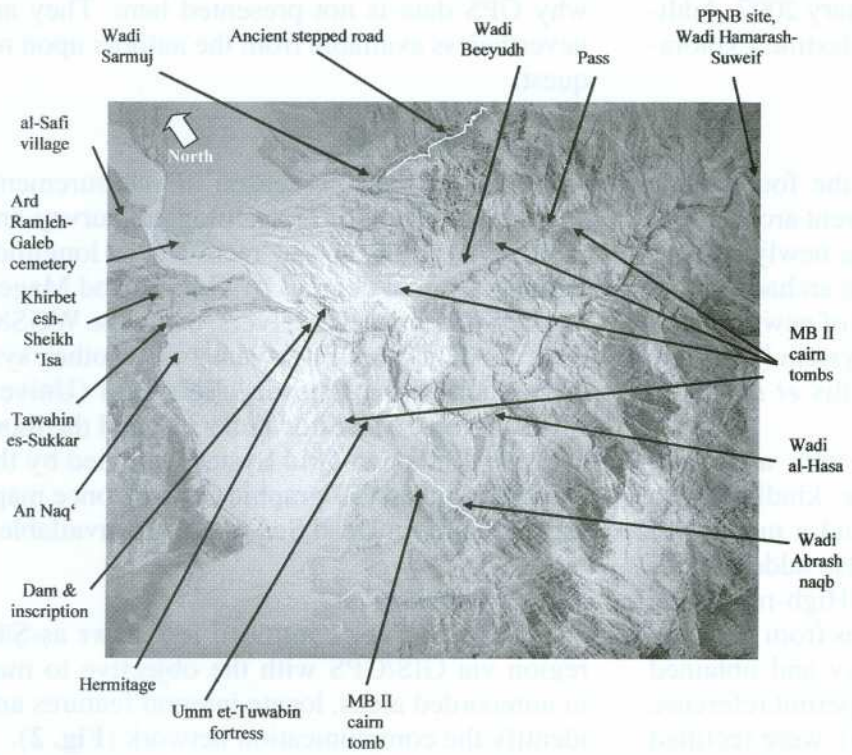
 Fig. 1b
Fig. 1b
Annotated 1953 aerial photograph of Ghor es-Safi surroundings
(courtesy of Royal Jordanian Geographic Centre, Amman)
Politis et al. (2007) - Fig. 2 - Annotated
Contour map of the Ghor es-Safi survey area from Politis et al. (2007)

 Fig. 2
Fig. 2
Contour map of the Ghor es-Safi survey area
Politis et al. (2007) - Fig. 3 - Map of Burial Sites
in Ghor es-Safi from Meimaris and Kritikakou (2005)

 Fig. 3.
Fig. 3.
Ancient Zoora in the Ghor es-Safi
(map by J.M. Farrant, based on 1992 aerial photographs)
Meimaris and Kritikakou (2005) - Safi in Google Earth
- Fig. 2 - Map of Sites
around Ghor es-Safi from Meimaris and Kritikakou (2005)

 Fig. 2.
Fig. 2.
Annotated 1992 aerial photograph of Zoora in the Ghor es-Safi
Meimaris and Kritikakou (2005) - Fig. 1a - Annotated
1953 aerial photograph of Ghor es-Safi from Politis et al. (2007)

 Fig. 1a
Fig. 1a
Annotated 1953 aerial photograph of Ghor es-Safi
(courtesy of Royal Jordanian Geographic Centre, Amman)
Politis et al. (2007) - Fig. 1b - Annotated
1953 aerial photograph of Ghor es-Safi surroundings from Politis et al. (2007)

 Fig. 1b
Fig. 1b
Annotated 1953 aerial photograph of Ghor es-Safi surroundings
(courtesy of Royal Jordanian Geographic Centre, Amman)
Politis et al. (2007) - Fig. 2 - Annotated
Contour map of the Ghor es-Safi survey area from Politis et al. (2007)

 Fig. 2
Fig. 2
Contour map of the Ghor es-Safi survey area
Politis et al. (2007) - Fig. 3 - Map of Burial Sites
in Ghor es-Safi from Meimaris and Kritikakou (2005)

 Fig. 3.
Fig. 3.
Ancient Zoora in the Ghor es-Safi
(map by J.M. Farrant, based on 1992 aerial photographs)
Meimaris and Kritikakou (2005)
| Phase | Dates |
|---|---|
| X | Late Ottoman, mid-19th to early 20th century AD |
| IX | Ayyubid/Mamluk, 12th–15th century AD |
| VIII | Abbasid, late eighth to early tenth century AD |
| VII | Early Byzantine, fifth to early seventh century AD |
| VI | Late Roman, second to fourth century AD |
| V | Nabataean first century BC to first century AD |
| IV | Iron Age IIC, c. seventh to sixth century BC |
| III | Middle Bronze Age IIA/B, c. 1900–1550 BC |
| II | Early Bronze Age I, ca. 3300–3000 BC |
| I | Pre-Pottery Neolithic A–B, c. 10,000–8,000 years ago |
Meimaris and Kritikakou (2005:51) relate the following regarding weekday designations and their accuracy for the tombstones found in Ghor es-Safi.
The numerous weekday references in the epitaphs of Ghor es-Safi, combined with the other chronological elements (era year, month day and/or indiction), can contribute to a more precise date of death on condition that all the dating particles of the epigraphic text are completely preserved. In this study 151 epitaphs fulfill this requirement: of these 104 show a perfect accordance between the various dating components (this number could increase to 107 since in inscr. nos. 135, 204 the weekday and in no. 221 the month day could be securely restored to offer an agreement, provided of course that the original numerals were accurate), while in 47 the weekday indicated on the tombstone differs from that obtained after conversion of the provincial date into modern one and use of the perpetual calendar (for tables cf. Grumel 1958, p. 316; Bickerman 1980, p. 60). In the latter case the discrepancy observed between the actually indicated and the calculated date could be of one to three weekdays. More specifically:
This evaluation of the evidence demonstrates that in more than half of the safely dated funerary texts the weekday indications are in compliance with those resulting from modern calculation, but that at the same time there is a high percentage of conflicting indications. These incongruities, which are more frequent from the early fourth until the early fifth centuries, are not a local phenomenon, but occur as well in other documentary sources of the Late Antiquity in East (more often) and West as K. Worp has showed (Worp 1991, pp. 221-227). In our opinion, the discord noticed in the Ghor es-Safi weekdays could be attributed to the following reasons:
- 1 day earlier. 12 cases (nos. 28, 52, 54, 72, 80, 112, 137, 203, 206, 230, 239, 251)
- 2 days earlier. 5 cases (nos. 21, 70, 193, 197, 216)
- 3 days earlier. 1 case (no. 51)
- 1 day later. 22 cases (nos. 23, 24, 66, 69, 79, 82, 86, 98, 99, 111, 128, 131, 132, 145, 150, 153, 177, 192, 220, 242, 250, 252)
- 2 days later: 5 cases (nos. 37, 50, 73, 88, 166)
- 3 days later. 2 cases (nos. 100, 236).
Worp arrived at similar conclusions having studied a smaller number of relevant material in East and West (Worp 1991, pp. 223-226).
- to a mistake made by the commissioner of the funerary inscription who sometimes did not remember the exact day on which a death or burial had occurred due to the span of time (from a few days to several weeks) intervened between the death or burial and the engraving and laying of the tombstone
- to a stonecutter's blunder which is evident for example in the confusion of the day numerals, as this of Δ = 4 with A = 1 (cf. inscr. no. 100 with three days difference in which the actual and converted weekday would coincide on a Sunday, if the weekday had been engraved as A instead of Δ) or that of round E = 5 with 0 = 9 (cf. inscr. no. 51 with three days difference which would have been eliminated, if the month day numeral had been carved as ΘΙ in the place of EI).
| Macedonian Month | Julian Equivalent | Duration (days) |
|---|---|---|
| Xanthikos | 22 March - 20 April | 29 |
| Artemisios | 21 April - 20 May | 30 |
| Daisios | 21 May - 19 June | 29 |
| Panemos | 20 June - 19 July | 30 |
| Loos | 20 July - 18 Aug. | 29 |
| Gorpiaios | 19 Aug. - 17 Sept. | 30 |
| Hyperberetaios | 18 Sept. - 17 Oct. | 29 |
| Dios | 18 Oct. - 16 Nov. | 30 |
| Apellaios | 17 Nov. - 16 Dec. | 29 |
| Audynaios | 17 Dec. - 15 Jan. | 30 |
| Peritios | 16 Jan. 14 Febr. | 29 |
| Dystros | 15 Febr. - 16 March | 30 |
| Epagomenai | 17 March - 21 March | 5 |
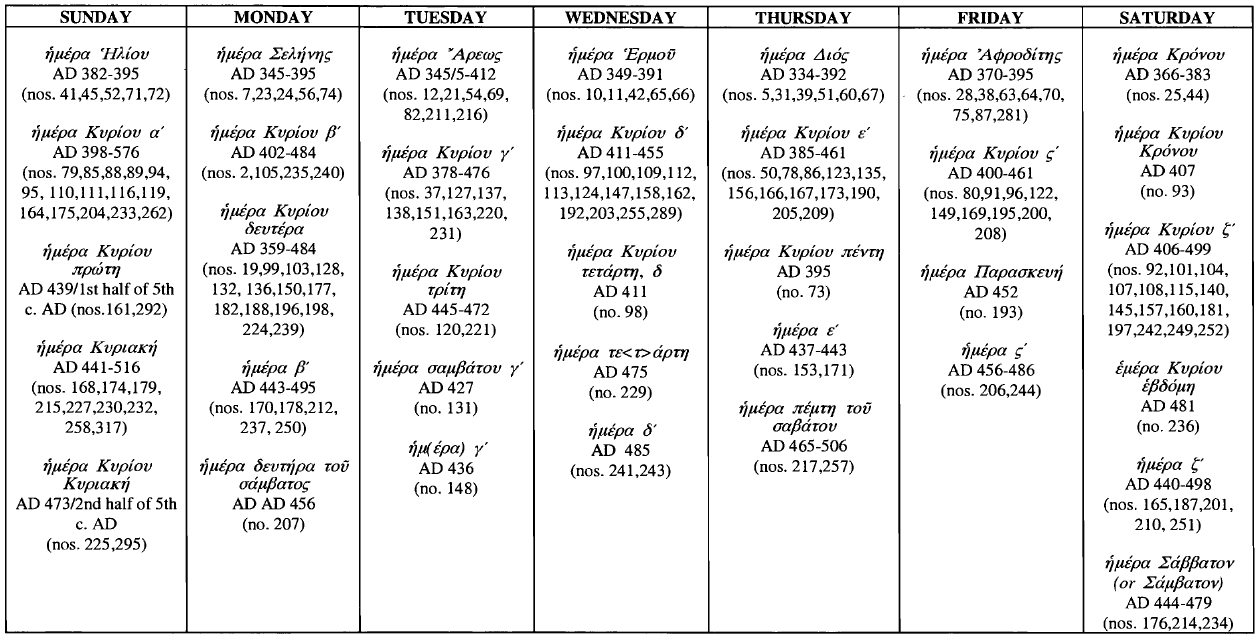 Fig. 15
Fig. 15Weekday Designation in Chronological Order
Meimaris and Kritikakou (2005)
Meimaris and Kritikakou (2005:51) relate the following regarding the hours recorded for the tombstones found in Ghor es-Safi.
The time of death is fixed even more accurately in an epitaph of AD 425 (no. 128) with the addition of the hour of death. The mention of the hour, which is so far unique at Ghor esSafi, consists of the introductory word ώρα and the cardinal numeral πέντε and is placed at the end of the dating formula (after era year, month day and weekday). For the rare instances of hour indication in the epitaphs of Palestine, see commentary of inscr. no. 128.
Meimaris and Kritikakou (2005:51-52) relate the following regarding the hours recorded for the tombstones found in Ghor es-Safi.
Finally, around the mid-fifth century the indiction, another important reckoning element, made its appearance in the local dating formula. This was originally a taxation system based on a cycle of fifteen years. The type of indiction employed in the provinces of Palestine and Arabia was the Constantinopolitan or Constantinian one introduced by Constantine the Great and starting on 1 September (on the indiction in general and its examples in Palestine and Arabia, see Meimaris in collab. with Kritikakou and Bougia 1992, pp. 3234). The indiction occurrences at Ghor esSafi amount to 17 (nos. 156, 162, 196, 221, 246248, 254, 257264, 302) with the earliest example dated in AD 438, the hitherto earliest attestation in Palestine (ibid., pp. 3334; for a late fourthcentury instance from Arabia, see ibid, and commentary of inscr. no. 156), and the latest in AD 591. Most of these indiction years (14 cases of which no. 221 is restored) correlate with the corresponding chronological data, offering in this way a more secure date (cf. for example inscr. no. 248 which confirms the indiction year's start on 1 September). The discordance between the indiction and the other dating particles, observed in two cases (nos. 260, 262), is not an unusual phenomenon for the sixth century inscriptions dated by the era of Provincia Arabia (ibid., pp. 157158) and at Ghor esSafi could be ascribed to the compiler's or letter cutter's failure to update the chronological elements since both texts are dated a few days after the beginning of a new era year.
The indiction reference occupies the last or penultimate place of the dating formula. It is comprised of the word ίνδικτιώνος in the abbreviated forms ΙΝΔ and ΙΝΔΙΚ (in no. 260 ΙΝΔΙΚΤ) followed by Greek numerical signs (the tens and units in descending order) and once by an ordinal number (no. 258). In three epitaphs (nos. 162, 196, 221) the indiction phrase is further augmented as follows: έν χρόνοις or έν χρό(νοις) + numerical sign + ίνδικ(τιώνος) (for examples of this phrase in Palestine and Arabia see ibid., p. 34). In one of these (no. 221) the word for indiction is given in full in the phonetic spelling [ίν]δικτιονος.
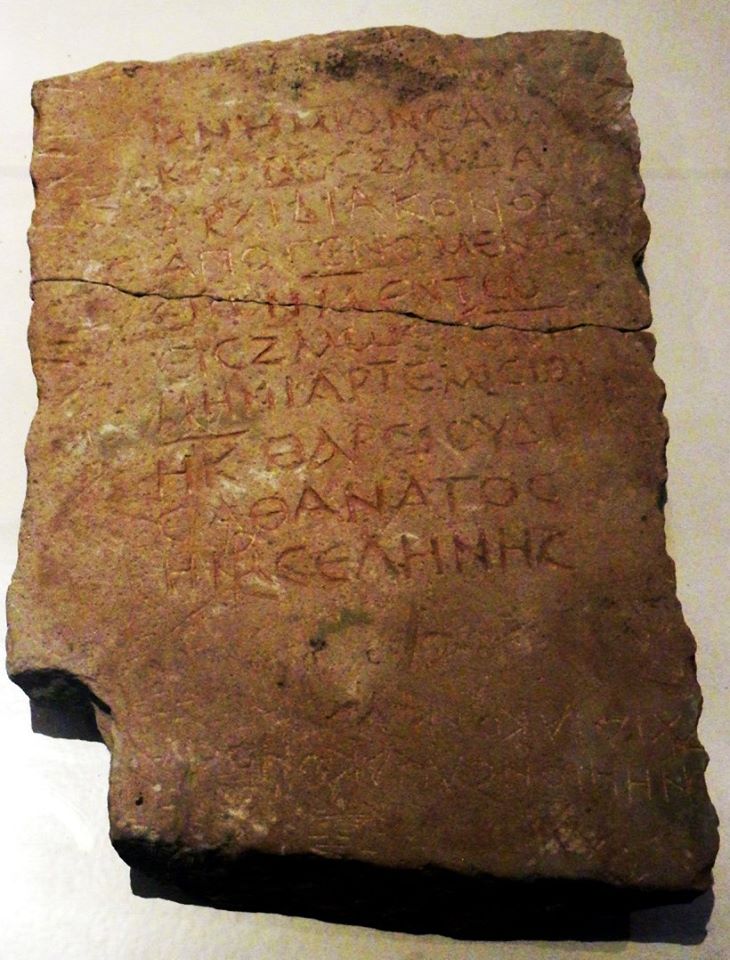 Tombstone of Samakon of Ghor es-Safi who died in the southern Cyril Quake
Tombstone of Samakon of Ghor es-Safi who died in the southern Cyril Quakephoto by Jefferson Williams
Three tombstones discovered in Ghor-es-Safi (Byzantine Zoara) provide an explicit date for the southern Cyril Quake. All three tombstones state that the victims died
during the earthquake. Collective chronological information is presented below:
- All three tombstones specified a date of 28 Artemisios which corresponds to 18 May/
- All three tombstones specified a year of 258 of the era of Province Arabia which spanned from 22 March 363 to 21 March 364 CE (using CHRONOS).
- Two tombstones specified Monday as the day of the week. The other tombstone did not specify a day of the week. Since 18 May 363 CE
fell on a Sunday and 19 May 363 CE fell on a Monday
(using CHRONOS),
the day of the week from the Safi tombstones may be incorrect. This is not unusual.
Meimaris and Kritikakou (2005:51) noted that 47 out of 151 epitaphs at Ghor es-Safi specified a day of the week that was incompatible with the date.
Further, they noted that
these incongruities [] are more frequent from the early fourth until the early fifth centuries.
- Siltha and Kyra died during the earthquake on 28 Artemisos (18 May). The day of the week was not specified.
- Obbe died during the earthquake on a Monday on 28 Artemisos (18 May).
- Samakon died during the earthquake on a Monday on 28 Artemisos (18 May).
Individual tombstones are shown and discussed below
- Color Photo of the Tombstone
of Siltha and Kyra
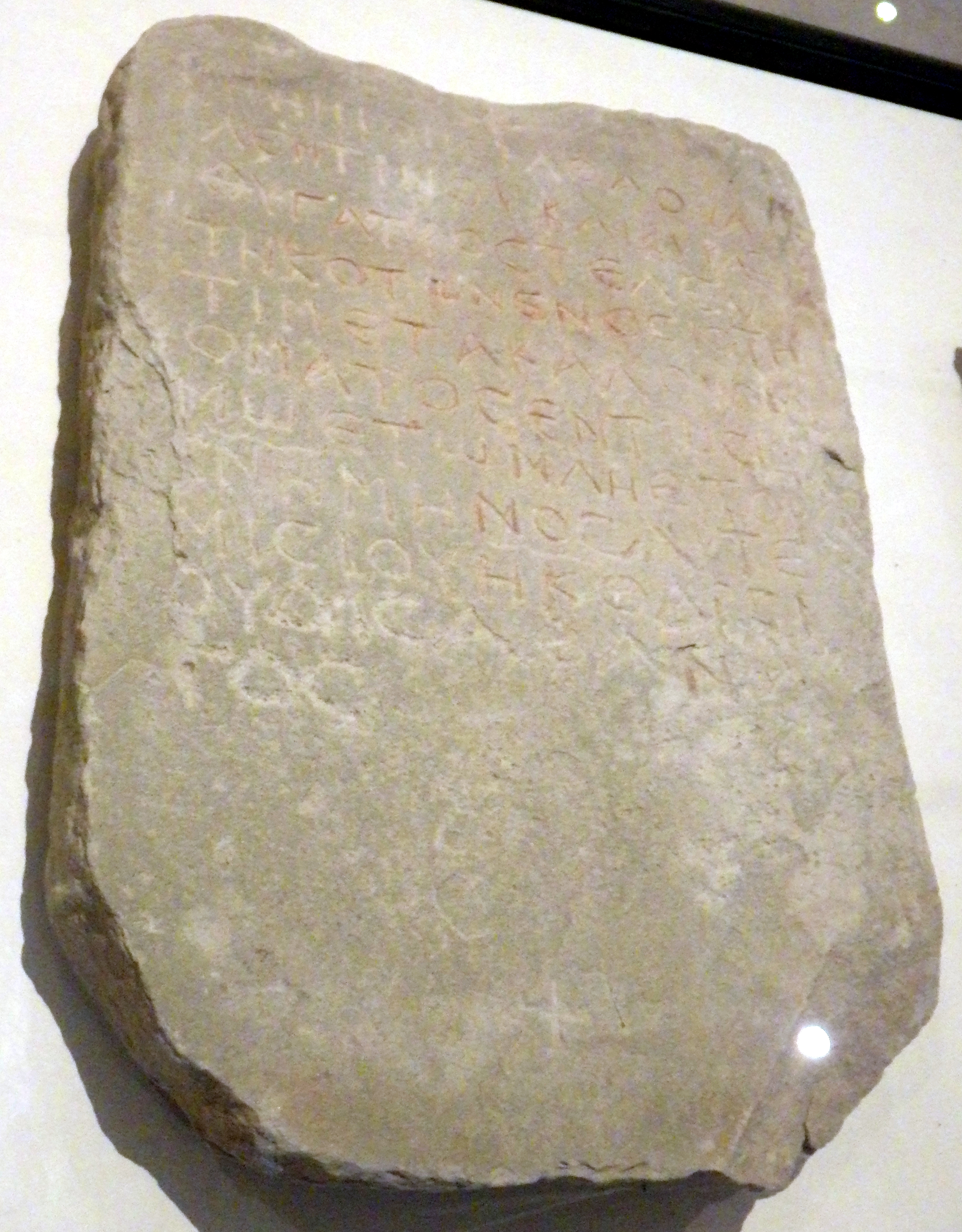
 Tombstone of Siltha and Kyra
Tombstone of Siltha and Kyra
Museum at the Lowest Place on earth near Safi, Jordan
Photo by Jefferson Williams
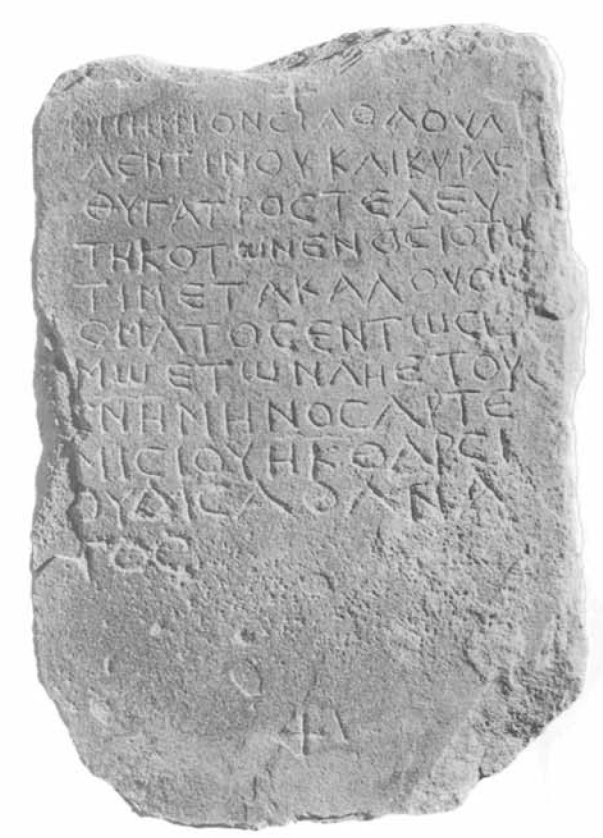 Inscription 22
Inscription 22Meimaris and Kritikakou (2005)
Meimaris and Kritikakou (2005:116-119) discuss this tombstone as follows:
22. Tombstone of greenish sandstone, rectangular in shape and curved at the upper and lower left corners. It is broken at the top and at the lower right corner. Inv. no.: Z38. Dimensions: 0.545x0.385x0.075 m. The smooth inscribed surface is weathered and flaked off at the middle left side, at the right side and at the bottom. Just above the inscription and below it towards the bottom a cross has been incised. The text is engraved and painted red except for the ninth letter kappa in the second line. The script follows the round alphabet and the letters are well cut and aligned. A gradual increase in the size of the letters is to be noted. Height of letters: 0.0110.025 m.
Bibl.: Unpublished.
Date: 28 Artemisios 258 E.P.A. = 18 May AD 363
EnglishCritical apparatus
Monument of Siltha, (daughter)
of Valentinus, and
of Kyra, (her) daughter, who have
both died in holiness, having a good
name, during the earthquake
(at the age) of 38 years
(Siltha's age), in (the) year
258, on (the) 28th (day) of
(the) month Artemisios.
Be of good cheer,
no one (is) immortal
Greek
Μνημΐον Σίλθα Ούα
λεντίνου και Κύρας
θυγατρός, τελευ
4 τηκότων εν όσιότη
τι μετά καλοϋ ονόματος εν τω σιζ
μώ ετών λη', έτους
8 σνη', μηνός 'Αρτεμισίου η κ'. Θάρσι,
ούδίς αθάνατος
I. 1: μνη μείον; Σίλθα for Σίλθας: nominative for genitive.
II. 34: τελευτηκότων (correct form τετελευτηκότων) for τετελευτηκυιών: the engraver uses the masculine present perfect participle although he refers to mother and daughter.
II. 67: σιζμώ is the phonetic spelling of the dative σεισμώ.
I. 7: a wavy horizontal bar above indicates the age numeral.
I. 8: the same wavy line above the year numeral.
I. 9: the inverted month day numeral is also denoted by the wavy horizontal bar; θάρσει.
I. 10: ουδείς.
Commentary
I. 1: For discussion on the name Σίλθα, see above commentary of inscr. no. 13.
II. 1-2: The name Ούαλεντΐνος, Greek transcription of the Latin cognomen Valentinus, is borne in this epitaph by a native person as indicated by his daughter's name. In Palestine and Arabia the form Ούαλεντΐνος is also attested in Roman and Early Byzantine inscriptions from Hauran (Der'a: Waddington, no. 2070m; Salchad: PAES IIIA, no. 168), Negev (Alt 1923, p. 61, no. 14 = SEG 8 [1937], no. 293; Nessana: Nessana 1, no. 75 [preserved fragmentarily]), 'Evron (Tzaferis 1987, p. 46*, no. 9 = SEG 37 [1987], no. 1518), in which it appears either alone or combined with Greek or Latin names. In a pilgrim's graffito at Wadi Haggag, Sinai (Negev 1977, p. 24, no. 62) an Egyptian bears this name ([Ού]αλεντϊνος AvovßfiovJ). For the feminine Ούαλεντΐνα, see below inscr. no. 193.
II. 2-3: The word "θυγατρός", which designates Kyra as the daughter of Siltha, is the only sure indication of kinship at Ghor es-Safi. The high frequency of the feminine name Κυρα in the epitaphs from this area (10 instances: nos. 22, 88, 143, 169, 172, 173, 175, 208, 232 and 312) is noteworthy if compared to its rare occurrence in the epigraphy of Palestine and Arabia. In these provinces Κυρα has been encountered only at Nessana (Nessana 1, no. 30d), at Wadi Haggag in Sinai (as a pilgrim's name, Negev 1977, nos. 57, 119) and in Hauran (Sâleh: PAES IIIA, no. 730). A Jewess bearing this name appears in an epitaph from Joppe (SEG 8 [1937], no. 140). Egypt has also yielded a few papyrological examples of this name (Preisigke 1922, col. 188, s.v.; Foraboschi 1967, p. 174, s.v.).
II. 3-6: The phrase "τελευτηκότων εν όσιότητι" implies that both Siltha and her daughter Kyra had led a pious life. "Όσιότης", holiness, piety, was a fundamental Christian virtue whose significance is stressed already in the New Testament (Luke 1:75; Eph. 4:24). Mention of this virtue is made at Ghor es-Safi in three more epitaphs (nos. 61,89,95; see also chapter on Burial terms and phrases) while it is unattested in Palestine and Arabia in contrast to the epithet "όσιος" or "όσιώτατος" which is frequently employed in these provinces as a title of ecclesiastical officers, especially bishops (see for example Gatier 1986, ind. gén.grec, s.w. όσιος, όσιώτατος, p. 230).
The accompanying expression "μετά καλοϋ ονόματος", is quite common. For its frequency and meaning see commentary of inscr. no. 91 (cf. also chapter on Burial terms and phrases).
II. 69: It is worth noting that in this and the following two epitaphs, apart from the time, the cause of death is indicated. As it is clearly stated in all three inscriptions the deceased persons were victims of an earthquake which is explicitly dated on Monday, 28 Artemisios of the year 258 of provincia Arabia, i.e., on 18 May AD 363. It is known that Palestine and its adjacent regions have suffered earthquakes some of them catastrophic from antiquity to the present day (for a list of seismic events since the first c. BC, see Arvanitakis 1899, pp. 158190; Amiran 195051, pp. 223 246; id. 1952, pp. 4862; for an updated and revised edition of this earthquake catalogue, see Amiran, Arieh and Turcotte 1994, pp. 260305; Nur and Ron 1996, pp. 7585; for the earthquakes from the second to the eighth centuries AD in Palestine and NW Arabia on the basis of literary and archaeological evidence, see Russell 1985, pp. 3759). The earthquake of 363 (for an elaborate study on this earthquake, see Russell 1980, pp. 4764) was recorded by a number of ancient writers, such as Ephrem, Gregory Nazianzen, Ammianus Marcellinus, Rufinus, Socrates, Sozomen, Theodoret, Theophanes and others (for an analytical list of the relative Greek and Syriac sources, see Brock 1977, pp. 276, 283286; Russell 1980, p. 61, n. 4). In these sources (except Ammianus) the earthquake was taken as a divine punishment that brought an end to the attempted rebuilding of the Temple in Jerusalem, instructed by the emperor Julian (who died ca. one month after the earthquake, 26 June AD 363), and was considered as a fulfilment of the prediction of Jesus (Matthew 24: 12; for the religious interpretation of this natural phenomenon, see Russell 1980, pp. 5052). However, the most detailed and accurate account of this earthquake appears in a letter included in a Syriac manuscript, discovered in 1975 by S. Brock in the Houghton Library of Harvard University (Harvard Syriac 99) and dated in 1899 (for a preliminary report, see Brock 1976, pp. 103107; for the full publication, see Brock 1977, pp. 267286). The letter is attributed to Cyril, bishop of Jerusalem (AD 350388); according to its editor it is rather pseudonymous, originally composed in Cyril's name in the early fifth c. AD (Brock 1976, pp. 106107; id. 1977, pp. 280283). A part of the text contains a catalogue of 23 sites affected by the 363 earthquake as well as the respective degree in their damage (Brock 1977, p. 276; Russell 1980, p. 51, fig. 4). From this list (and the other sources mentioned above) it is evident that the earthquake afflicted most of Palestine and Transjordan since the consequent destruction extended from Paneas in the north through Petra in the south and from the coast through the Jordan Valley and beyond it (Russell 1980, pp. 5660, who combining historical and archaeological data added more settlements to those affected by the earthquake; Russell 1985, p. 42; Amiran, Arieh and Turcotte 1994, p. 265).
Although Zoora is not mentioned in the list of cities appearing in the letter attributed to Cyril, a hint for the affliction of the Southern part of the Dead Sea (where Zoora is located) by the 363 earthquake is already supplied in a passage of Saint Jerome, noting a seiche (standing wave in the Dead Sea) associated with an earthquake which caused destruction to Areopolis (Rabba) in Moab (Russell 1980, pp. 5354; Amiran, Arieh and Turcotte 1994, pp. 265 and 295, appendix 6). The three epitaphs from Ghor esSafi (Zoora) not only confirm beyond any doubt the association of this part of the Dead Sea with the earthquake of 363, but they also enlist Zoora among the cities that suffered damage during it, as indicated by the loss of four people, a number which may increase with the discovery of new inscriptions.
Another valuable piece of evidence provided by the Ghor es-Safi epitaphs is the precise date of the earthquake: Monday (ήμερα Σελήνης: the weekday is given in two of the three inscriptions, nos. 23 and 24), 28 Artemisios of the year 258 of provincia Arabia which is equivalent to 18 May AD 363. In the letter attributed to Cyril the date is given in the Syrian way: Monday, 19 Iyyar of the year 674 of the kingdom of Alexander the Greek/Seleucid era (Brock 1977, p. 276) which falls on the 19th of May AD 363 (ibid., p. 268). The letter mentions in addition the exact time of the two major tremors of the earthquake which took place at the third and at the ninth hour of the night of Sunday to Monday, 18th to 19th of May. This is probably the reason for the discrepancy of one day between the two sources. In spite of this, however, the three inscriptions from Ghor esSafi and the letter attributed to Cyril are complementary to one another. On the one hand, the epigraphic evidence supports the authenticity and the historical value of the manuscript and, on the other hand, the manuscript offers supplementary evidence concerning the exact time of the two major and disastrous tremors of the 363 earthquake.
It is noteworthy that the three Ghor es-Safi epitaphs are, to our knowledge, the only epigraphical attestations of an earthquake occurrence and its date in this region. A circumstantial epigraphic evidence on an earthquake is provided by a dedicatory inscription found in the neighbouring city of Rabbat Moab (Areopolis). Its text, dated in the year 492 E.P.A. (= AD 597/8), commemorates the reconstruction of an ecclesiastical building after its damage in an earthquake "... άνενεώθη έτους υ^β' μετά το σισμόν" (Zayadine 1971, pp. 139141 who briefly comments on the possible earthquakes concerned).
Although the present tombstone belongs both to Siltha and her daughter Kyra, only the age of the mother is indicated. A common burial of father and son but not after an earthquake is also attested in a sixth c. epitaph from Elusa (Kirk and Gignoux 1996, p. 177, no. 33). A close parallel for a common burial of two members of the same family, killed in an earthquake, is offered by an epitaph of the late fourth c. AD from Cyrene, where mother and son, victims of an earthquake ("έτελεύτησαν επί άγροΰ Μυροπωλά σισμοΰ γενομένου"), were buried in the same tomb (Bacchielli, Reynolds and Rees 1992, pp. 1522).
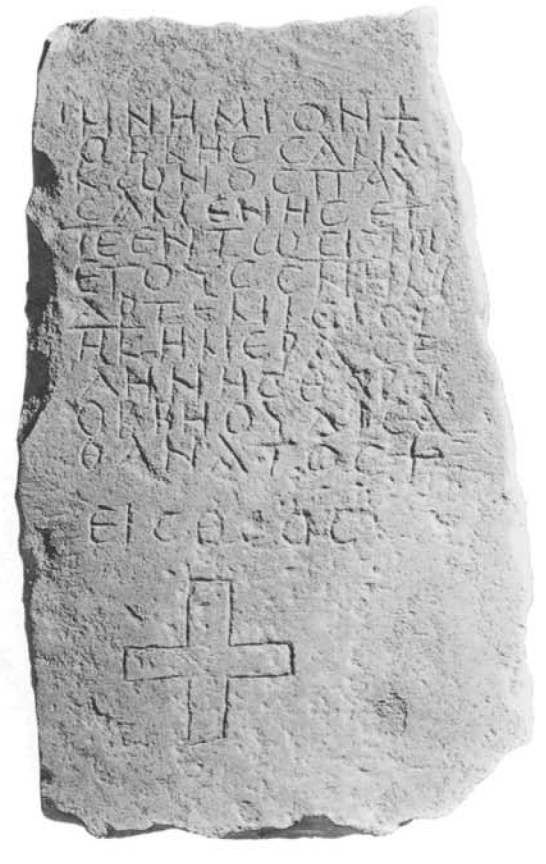 Inscription 23
Inscription 23Meimaris and Kritikakou (2005)
Meimaris and Kritikakou (2005:119-120) discuss this tombstone as follows:
23. Tombstone of yellowish sandstone, almost rectangular in shape, broken at the edges. Inv. no.: Z 165. Dimensions: 0.45x0.28x0.08 m. The inscribed surface, which has been smoothed, is chipped at the left side and weathered at the right inscribed area. Just below the inscription a large outlined isosceles cross is engraved. The text is also engraved, but remains of red paint are discernible throughout it. Traces of faint incised guidelines are visible especially at the first lines. The script is of the round alphabet and carefully executed. Height of letters: 0.0120.02 m.
Bibl.: Unpublished.
Date: 28 Artemisios 258 E.P.A. = 18 May AD 363
EnglishCritical apparatus
Monument of Obbe,
(daughter) of Samakon,
who died (at the age)
of 15 years during the
earthquake, in (the) year
258, on (the) 28th (day)
of (the) month Artemisios,
on (the) day of (the) Moon
(Monday). Be of good
cheer Obbe, no one (is)
immortal.
One (is) the God.
Greek
+ Μνημΐον + ν
"Οββης Σαμά ν
κώνος, παυ ν
4 σαμένης έτ(ών) ν
ιε' εν τω σιζμώ,
έτους σνη', μη(νός)
'Αρτεμισίου
8 η κ', ήμερα Σε
λήνης. Θάρσι,
"Οββη, ούδίς ά
θάνατος. +
12 Εις Θεός. vv +
1. 1: the line starts and ends with an incised cross; μνη μείον.
1. 4: the abbreviation of the word ετών consists of the first two letters and a small oblique stroke at the upper right part of the letter tau.
1. 5: a horizontal bar above the age numeral; σιζμώ for σεισμώ (for this phenomenon see critical apparatus of inscr. no. 22).
1. 6: the year numeral bears a horizontal stroke above; the word μηνός is abbreviated by the first two letters, with the superscription of a small eta over mu.
1. 8: the inverted month day numeral is denoted by a horizontal bar.
1. 9: θάρσει.
1. 10: ουδείς.
1. 11: the line ends with a cross.
1. 12: traces of a small engraved cross are visible at the end of the line.
Commentary
I. 2: The feminine name "Οββη is the Greek equivalent of the Arabic diminutive Hubb (PAES IIIA, p. 64, no. 69) which derives from the Semitic root hbb, "to love". Its parallels are encountered almost exclusively in the area of Hauran: es-Summakiyât (PAES IIIA, nos. 69, 89), 'Orman (ibid., no. 699), el-Mushennef (Dussaud and Macler 1902, p. 666, no. 72), Shakka (Dunand 1932, p. 402, no. 11) and Bostra (Sartre 1982, no. 9380 [if the name Όβη is complete]; Sartre [1985, p. 220, s.v. Οβη] speaks for an unpublished example from Umm el-Jimâl). The name "Οββη has been recently recorded in two epitaphs of unknown provenance (SEG 40 [1990], nos. 1430, 1431[= SartreFauriat 2001, vol. I, pp. 258260, no. 16]) belonging plausibly to the same family which originated from Hauran but later migrated from there probably to the Damascus area. For a possible kinship of Obbe with Samakon referred to in the following epitaph, see commentary of inscr. no. 24.
II. 2-3: Σαμάκωνος is the genitive of the Hellenized Semitic name Σαμάκων which appears in Ghor esSafi also in inscr. nos. 24 and 102. This name has been attested so far only in three mosaic inscriptions found in a church at 'Evron and referring to a priest (πρεσβύτερος) of this town in whose days the local church was built and embellished (Tzaferis 1987, pp. 4243*, no. 5; p. 44*, no. 7; p. 47*, no. 11). The forms Σόμακος (PAES IIIA, nos. 355, 469, 490) and Σονμάκος (ibid., no. 398), encountered in epitaphs from Umm el-Jimâl in Hauran, are plausibly variants of Σαμάκων. All three names are possible Greek transcriptions of a Semitic name which derives from the root smk , "to support" or "to increase, to elevate".
11. 3-4: "Παυσάμενος, ένη" is the second popular funerary participle after "αποθανών, οϋσα" in the epitaphs of Ghor esSafi (for its ca. 40 examples see index 6) but is quite rare in the rest of Palestine and Arabia (cf. the form "έπαύσετο" at Ayûn in Hauran: Waddington, no. 1986). For the expanded formula "παυσάμενος τοϋ βίου" see commentary of inscr. no. 114, while for the compound form "άναπαυσάμενος" see chapter on on Burial terms and phrases).
1. 5: For the earthquake of AD 363, see above inscr. no. 22.
1. 12: The religious formula "εις Θεός" is placed at the end of the inscription; this is an exceptional case, for "εις Θεός" is as a rule the introductory phrase of the Ghor es-Safi epitaphs.
-
Color Photo of the Tombstone
of Samakon

 Tombstone of Samakon
Tombstone of Samakon
Museum at the Lowest Place on earth near Safi, Jordan
Photo by Jefferson Williams
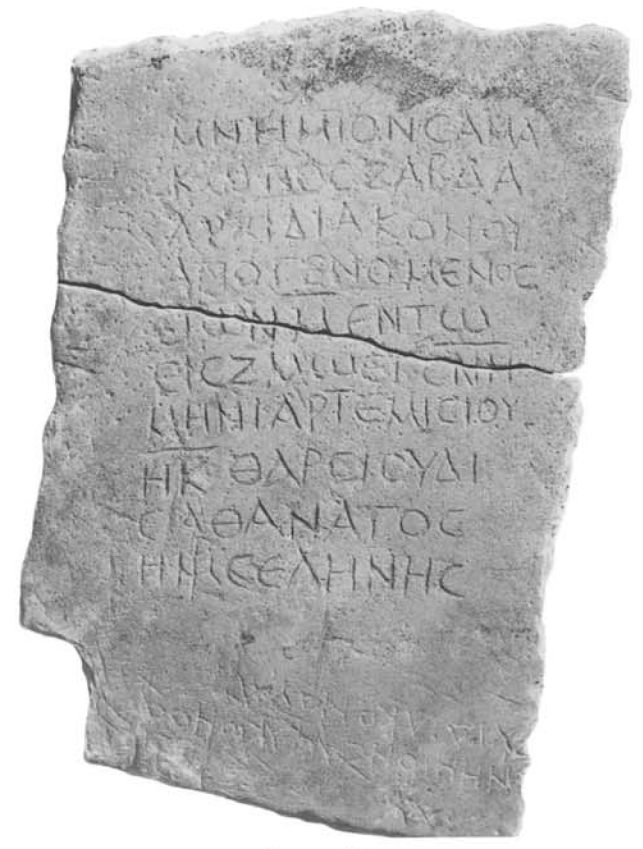 Inscription 24
Inscription 24Meimaris and Kritikakou (2005)
Meimaris and Kritikakou (2005:120-121) discuss this tombstone as follows:
24. Tombstone of whiteyellowish sandstone, almost rectangular in shape, broken at the lower left corner and mended from two fragments. Inv. no.: Z280. Dimensions: 0.56x0.38x0.07 m. The inscribed surface, which has been smoothed, has some scratches. It seems that the lettercutter started to engrave the epitaph the normal way, but at the end of the second line, when he realized that he had omitted the patronymic of the deceased (text aO he turned the tombstone all the way round and started writing the text from the beginning, this time in bigger characters (text a2). The text ai is only engraved, while the text a2 is engraved and painted over in red. The script belongs to the round alphabet with well cut letters. Height of letters: 0.0080.025 m.
Bibl.: Unpublished.
Date: 28 Artemisios 258 E.P.A. = 18 May AD 363
EnglishCritical apparatus
Monument of Samakon,
(the) archdeacon, who died...
Monument of Samakon, (son) of Zabdas,
(the) archdeacon, who died (at the age)
of 40 years during the earthquake,
in (the) year 258, on (the) 28th (day)
of (the) month Artemisios.
, Be of good cheer, no one
(is) immortal. (He died) on (the)
day of (the) Moon (Monday).
Greek
a1 [Μ]νημΐον Σαμάκωνος ά
ρχιδιακόνου, ά (πογενομένου)
a2 Μνη μΐον Σαμά
κώνος Ζάβδα,
άρχιδιακόνου,
4 άπογενόμενος
ετών μ' έν τω ν
(σει) ζμώ, ετ(ους) σνη',
μηνί 'Αρτεμισίου
8 ηκ'. Θάρσι, ούδί- ν
ς αθάνατος. νν
Ήμ(έ)ρ(α) Σελήνης.
a1 1. 1: [μ]νη μείον: the first letter is lost.
1. 2: alpha is probably the initial letter of the word άπογενομένου which was left half-finished.
a1 1. 1: μνη μείον.
1. 4: άπογενόμενος for άπογενομένου: the engraver puts the past participle in nominative instead of genitive despite the fact that the deceased man's name and his ecclesiastical office are given in genitive.
1. 5: a horizontal bar above the age numeral.
1. 6: εισζμώ for σεισμώ: transposition of the letters of the first syllable and phonetic spelling of the second sigma (for the latter phenomenon see also inscr. nos. 22, 23); the word έτους is abbreviated by the first two letters and a small oblique stroke at the upper right part of the letter tau (for the same stroke see inscr. no. 23); a horizontal bar above the year numeral.
1. 7: μηνί for μηνός.
I. 8: the month day numeral is inverted and denoted with a horizontal bar above it; θάρσει.
II. 8-9: ουδείς.
1. 10: the word ήμερα is abbreviated by its first letter and a ligature formed by the two consonants of the following syllables.
Commentary
Text a2, 11. 1-2: For the personal name Σαμάκων, see above commentary of inscr. no. 23. The archdeacon Σαμάκων, like "Οββη, daughter of Samakon, mentioned in the previous inscr. (no. 23), was killed during the earthquake of AD 363 as is explicitly stated in 11. 46. Judging from his age (40 years), Samakon could probably be identified with the father of the fifteen years old Obbe as her patronymic reveals. Although Siltha and her daughter Kyra, victims of the same earthquake (inscr. no. 22), shared the same grave, Samakon and Obbe if they were indeed members of the same family were buried separately as indicated by their tombstones.
1. 2: The patronymic Ζάβδας, derived from the Aramaic root zbd, "gift", is one of the personal names, simple or compound (e.g. Ζαβδάλλας), employed in Semitic dialects in order to express the idea that the child is a gift of God (Caquot 1962, p. 244; Sartre 1985, p. 201, s.v. Ζαβδάλλας and p. 202, s.v. Ζάβδος). Semitic names derived from the root zbd appear frequently in Palmyrene and Nabataean inscriptions (Sartre 1985, p. 202; cf. also Maraqten 1988, p. 157, s.v. zbdy; Al Khraysheh 1986, p. 72, s.v. zbdw; Abbadi 1983, pp. 103104, s.v. zbdy), while in Greek they occur in a variety of transcriptions which seem to follow the local pronunciations and the vocalization of the original stem. In Palestine and Arabia the name Ζάβδας is attested mainly in Hauran and to a lesser degree in Transjordan in the following variants: Ζάβδας (Hauran: PAES IIIA, no. 499; Rihab: Gatier 1998, p. 398, no. 100 [dubious] and p. 416, s.v.), Ζάβδος (Hauran: Waddington, nos. 2070i, 2404; PAES IIIA, nos. 385, 408 [Ζ]άβ[δ]ε. vocative of Ζάβδος or more probably the feminine Ζάβδη], 483, 651, 709, 7875 ; Dunand 1932, p. 413, no. 53; Sartre 1982, nos. 9211, 9225), Ζαβδέος (Hauran: PAES IIIA, no. 765 with parallels from Egypt), Ζαβδίων (Gerasa: Welles 1938, pp. 373374, no. 2; pp. 407408, no. 71; Gatier 1985, p. 308; Gatier 1996, pp. 4748, no. 1= SEG 46 [1996], no. 2057; Hammat Gader: Di Segni 1997, pp. 198199, no. 11; Moab: Canova 1954, no. 88), Ζάβεδος (Moab: ibid., no. 354), Ζαβοϋδος (Hauran: PAES IIIA, nos. 129, 314, 320; Waddington, no. 2054; Dussaud and Macler 1902, p. 665, no. 71; Dunand 1932, p. 574, no. 117), Ζέβεδος (Gerasa: Welles 1938, p. 400, no. 54; p. 428, no. 154) and in the diminutive forms Ζοβάϊδος (Hauran: CIG III, no. 4573c; Waddington, nos. 2150, 2210a; PAES IIIA, nos. 226, 803; Dunand 1934, no. 75; Gerasa: Welles 1938, p. 429, no. 156; Gatier 1982, pp. 272273, no. 3), Ζόβεδος (Hauran: PAES IIIA, no. 2127), Ζοβέϊδος (Hauran: ibid., no. 1979), Ζοάβειδος (Hauran: ibid., no. 369), Ζωβείδης (Moab: Canova 1954, no. 397). For more variants of the name from Syria and Egypt, see Wuthnow 1930, pp. 47, 48, 49, 50.
1. 3: The ecclesiastical title of the archdeacon (άρχιδιάκονος or άρχιδιάκων), borne by Samakon, is an important one. It was held by the senior deacon of each bishopric. As a leading deacon, he enjoyed several privileges. Among his duties were to make the proper arrangements for the services, to observe the traditional Church ritual and to instruct the new candidates for minor clerical ranks. As the bishop's personal deacon he conveyed the bishop's order to the clergy and the people, he occasionally substituted the bishop at Synods and on the death of a bishop or if a seat fell vacant, he acted as the episcopal guardian until the election of a new bishop (for more information on this office, see Meimaris 1986, pp. 178182). Since it is known that only one archdeacon served in each diocese we may assume that Samakon was the άρχιδιάκονος of the local bishopric of Zoora (see below inscr. no. 27).
In Palestine άρχιδιάκονοι are attested in 'Evron (Tzaferis 1987, p. 40*, no. 3; p. 42*, no. 5 [same person]; p. 44*, no. 7 = SEG 37 [1987], nos. 1512, 1514, 1516), at Deir elQilt in the Judaean Desert (Schneider 1931, p. 321, no. 80; p. 324, no. 136), Karmiel (SEG 42 [1992], no. 1467), Kafr Kama (SEG 45 [1995], no. 1954), Moza (Meimaris 1986, p. 181, no. 902), Nessana (Nessana 3, no. 57.2, 26), Shivta (Negev 1981, pp. 6162, no. 68) and at the Monastery of St. Catherine in Sinai (Sevcenko 1966, p. 263, no. 8). In the province of Arabia the office is encountered in inscriptions from Jaber (Meimaris 1986, p. 181, no. 898), Khirbet Mekhayyat (Di Segni 1998, p. 441, no. 39) and 'Ayun Musa (ibid., p. 452, no. 60) on Mount Nebo, as well as at Umm alRasas (SEG 37 [1987], no. 1555; Piccirillo 1994, p. 247, no. 4).
I. 4: For the rare use of the participle άπογενόμενος in the epitaphs of Ghor esSafi, see above commentary of inscr. no. 9.
II. 5-6: For the earthquake of AD 363, see commentary of inscr. no. 22
| Effect | Location | Image(s) | Description |
|---|---|---|---|
|
Burial Sites in Safi
 Fig. 3.
Fig. 3.Ancient Zoora in the Ghor es-Safi (map by J.M. Farrant, based on 1992 aerial photographs) Meimaris and Kritikakou (2005) |

 Tombstone No. 22 - Siltha and Kyra
Tombstone No. 22 - Siltha and KyraMeimaris and Kritikakou (2005) 
 Tombstone No. 23 - Obbe
Tombstone No. 23 - ObbeMeimaris and Kritikakou (2005) 
 Tombstone No. 24 - Samakon
Tombstone No. 24 - SamakonMeimaris and Kritikakou (2005) |
Three tombstones discovered in Ghor-es-Safi (Byzantine Zoara) provide an explicit date for the southern Cyril Quake.
All three tombstones state that the victims died during the earthquake |
-
Earthquake Archeological Effects chart
of Rodríguez-Pascua et al (2013: 221-224)

 Earthquake Archeological Effects (EAE)
Earthquake Archeological Effects (EAE)
Rodríguez-Pascua et al (2013: 221-224)
| Effect | Location | Image(s) | Description | Intensity |
|---|---|---|---|---|
|
Burial Sites in Safi
 Fig. 3.
Fig. 3.Ancient Zoora in the Ghor es-Safi (map by J.M. Farrant, based on 1992 aerial photographs) Meimaris and Kritikakou (2005) |

 Tombstone No. 22 - Siltha and Kyra
Tombstone No. 22 - Siltha and KyraMeimaris and Kritikakou (2005) 
 Tombstone No. 23 - Obbe
Tombstone No. 23 - ObbeMeimaris and Kritikakou (2005) 
 Tombstone No. 24 - Samakon
Tombstone No. 24 - SamakonMeimaris and Kritikakou (2005) |
Three tombstones discovered in Ghor-es-Safi (Byzantine Zoara) provide an explicit date for the southern Cyril Quake.
All three tombstones state that the victims died during the earthquake |
VIII+ |
Chlouveraki, Stephania (2002) The Basilica of Aghios Lot Mosaic Pavements Conservation Project in Jordan
, HNES Website
Meimaris, Y. E. and K. Kritikakou (2005). Inscriptions from Palaestina Tertia, National Hellenic Research Foundation.
Politis, K. D. et al. (2005) Survey and Excavations at Ghawr as-Safi 2004
. Annual of the Department of Antiquities of Jordan. 49: 313–326.
Politis, Konstantinos, O'Hea, Margaret, and Papaioannou, Georgios (2007) Ghor es-Safi survey and excavations 2006-2007
, Annual of the Department of Antiquities of Jordan, 51, 199-210.
Politis, K.D. (2004) Excavations at Ghor es-Safi 2002, Tawahin es-Sukkar and Khirbet Sheik ‘Isa in the Ghor es-Safi (ancient Zoara)
, HNES Website
Report on the Survey and Excavations at Ghor es-Safi 2004
, HNES Website
Photos of Ghor Es-Safi at ACOR
Hellenic Society for Near Eastern Studies (HSNES) website
Webpage for Stefania Chlouveraki at the University of Attica - JW: I think I met her at Safi in Jordan in two thousand and something
The Earthquake of 363 CE at www.inscriptionsisraelpalestine.org
Avi-Yonah, Michael. The Madaba Mosaic Map. Jerusalem, 1954. Color
reproductions of the map with comments and bibliography on the
place names. See plates 3 and 4 for the southeast Dead Sea region.
Bennett, Crystal-M. "Soundings at Dhra', Jordan." Levant 1 2 (1980):
30-39.
King, G. R. D., et al. "Survey of Byzantine and Islamic Sites in Jordan:
Third Season Preliminary Report (1982), the Southern Ghor." Annual of the Department of Antiquities of Jordan 31 (1987): 439-459.
Le Strange, Guy, trans. Palestine under the Moslems: A Description of
Syria and the Holy Land from A.D. 650 to 1500 (1890). Beirut, 1965.
See pages 286-292 for translated passages of references to Zughar
and the cities of Lot.
MacDonald, Burton, The Southern Ghors and Northeast.
'Arabah Archaeological Survey. Sheffield Archaeological Monographs,
5. Sheffield, 1992. Results of the most recent survey in the Safi, Feifa, and
Khanazir areas.
Rast, Walter E., and R. Thomas Schaub, eds. The Southeastern Dead
Sea Plain Expedition: An Interim Report of the 1977 Season. Annual of
the American Schools of Oriental Research, 46. Cambridge, Mass.,
1981. The articles by Ortner, Donahue, Harlan, McCreery, Adovasio and Andrews, and Finnegan provide necessary background for
interpreting the Bronze Age settlement patterns.
Schaub, R. Thomas, and Walter E. Rast. Bab edh-Dhrd': Excavations
in the Cemetery Directed by Paul W. Lapp, 1965-67. Reports of the
Expedition to the Dead Sea Plain, Jordan, vol. 1. Winona Lake, Ind.,
1989. Final report of Lapp's cemetery excavations. Includes analytical and synthetic studies of all the artifacts and interpretation of the
cultural and historical significance of the cemetery; a summary of
previous work in the southeast Dead Sea region (chap. 1) ; and a
complete bibliography on the Early Bronze Age of the Southeast
Dead Sea Plain.
Gubser, Peter. Politics and Change in Al-Karak, Jordan. London, 1973.
Sociopolitical study of the Kerak district (including the Southern
Ghors) focused on the fabric and dynamics of traditional and contemporary political society. Offers interesting insights for understanding the relationship between settlements in the highlands and
the Lower Ghors.
Harland, J. Penrose. "Sodom and Gomorrah. Part I. The Location of
the Cities of the Plain" and "Part II. The Destruction of the Cities
of the Plain." In Biblical Archaeologist Reader, edited by G. Ernest
Wright and David Noel Freedman, pp. 41-75 . Garden City, N.Y.,
1961. Outdated on the archaeological and geological sections but
helpful in bringing together summaries and many of the texts of
ancient writers on the Dead Sea and the Sodom tradition.
Howard, David M., Jr. "Sodom and Gomorrah Revisited." Journal of
the Evangelical Theological Society 27 (1984): 385-400. Offers a
conservative interpretation of the biblical texts, with summaries
of references to Zoar in the literature. The assessment of archaeological
evidence needs to be supplemented with the article by Rast (below).
Khouri, Rami G. The Antiquities of the Jordan Rift Valley. Amman, 1988.
Popular, detailed, readable summary of the most recent archaeological
surveys in the Southern Ghors, based on published accounts,
interviews with the archaeologists, and extensive trips to die area.
Krieger, Barbara. Living Waters: Myth, History, and Politics of the Dead
Sea. New York, 1988. Balanced account of ancient stories, current
theories, present exploitation, and future possibilities of the Dead
Sea region.
Politis, Konstantinos D. '"Ain 'Abata." In The New Encyclopedia of
Archaeological Excavations in the Holy Land, vol. 1, pp. 336-338. Jerusalem and New York, 1993.
Rast, Walter E. "Bab edh-Dhra and the Origin of the Sodom Saga."
In Archaeology and Biblical Interpretation: Essays in Memory of D.
Glenn Rose, edited by Leo G. Perdue et al., pp. 185-201 . Atlanta,
1987. Examines the Sodom tradition, integrating research on its origins
with recent archaeological evidence. Excellent bibliography.
Schaub, R. Thomas. "Bab edh-Dhra'." In The New Encyclopedia of
Archaeological Excavations in the Holy Land, vol. 1, pp. 130-136 .
Jerusalem and New York, 1993. Convenient, up-to-date summary of
the archaeological results in the site and cemetery.
